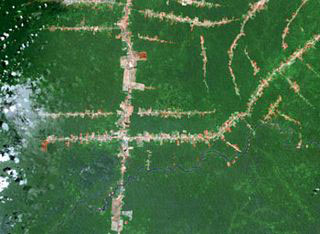Global warming could trigger 8-degree temperature rise in Amazon rainforest
Global warming could trigger 8-degree temperature rise in Amazon rainforest
Impact on biodiversity, agriculture would be devastating
mongabay.com
February 28, 2007
Tuesday the Brazilian government announced the release of a series of scientific studies, including one by the national space agency (INPE) that projects a 4 to 8 degree-Celcius rise in temperatures in the Amazon Basin by 2100 if nothing is done to combat global climate change.
The research, conducted by INPE scientist Jose Marengo, also warned of increasing probability of drought in the northeastern Amazon, with a 15-20 percent drop in rainfall under a pessimistic scenario.
A 4-8 degree increase in temperatures along drier would cause widespread changes to the Amazon, likely triggering a shift from humid rainforest to drier savanna ecosystems, as well as affecting agriculture and hydroelectric power generation. Fires, already a major concern in the region, would also become more frequent and intense.
 “Fishbone” deforestation in the Amazon. Courtesy of GoogleEarth. |
Marengo’s model further indicates that the Pantanal, the world’s largest wetland, is at risk from climate change. It shows the region could be affected by higher temperatures and worsening droughts.
Deforestation in Brazil is contributing to global warming. When trees are cut, their stored carbon is released into the atmosphere. Brazil generally has the world’s highest deforestation rate, though in 2006, forest loss in Indonesia was higher as a result of widespread forest fires, illegal logging, and land-clearing for oil palm plantations.
Marengo’s model is not the first to forecast a drier, warmer Amazon. One climate model produced by the Hadley Center of the UK Meteorological Office shows that unchecked climate change could produce permanent “El Niño” conditions resulting in catastrophic die off of Amazonian forest by 2080.
“The threat of a “permanent El Niño” is therefore to be taken very seriously,” said Dr. Philip M. Fearnside of the National Institute for Research in the Amazon (INPA) in an interview with mongabay.com last year. “Again, it depends on how seriously society takes the problem to be. If fossil-fuel combustion and deforestation are reduced to reflect the importance of the problem, then the worst could be avoided. If this does not happen, the danger of a “runaway greenhouse” escaping from human control becomes much greater. Disintegration of the Amazon forest, with release of the carbon stocks in the biomass and soil, would be a significant factor in pushing us into a runaway greenhouse.”
More Amazon news